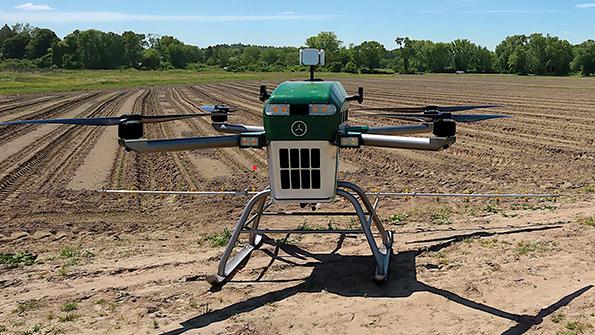
Guardian’s SC1 aerial-application eVTOL can cover 40 acres/hr.
Massachusetts-based startup Guardian, which is developing an unmanned electric-vertical-takeoff-and-landing (eVTOL) crop duster, has hired Leif Jentoft from startup Righthand Robotics as its new chief product officer.
Speaking to the AAM Report in his first interview since joining Guardian, Jentoft said his background as founder and chief strategy officer of Righthand Robotics–a series C supply chain robotics company–will be an ideal fit for the agricultural eVTOL segment.
He also recounted how growing up in Minnesota as the neighbor of a widow who lost her husband in a crop-dusting accident–one of the most fatal civilian forms of aviation–inspired him to apply his robotics expertise to try to prevent such tragedies in the future.
“When you look at the hazards of chemical spraying, it seems to me that this is one of those jobs where the best solution for the customer is a robot,” Jentoft says. “Moreover, when you look at the ways these chemistries are evolving, people now want to use gentler chemicals that are applied more precisely. When you’re restricted by things like pilot availability or the availability of large equipment, it really limits your ability to use some of these large approaches.”
In joining Guardian, which is focused exclusively on aerial crop spraying, Jentoft said he was also encouraged by the startup’s realistic path to market, which he expects to be easier than other eVTOL companies that are developing harder-to-certify passenger-carrying vehicles.
“There’s a lot of simplifications that come with working in the agriculture space that aren’t the case when you’re looking at more complicated market applications where you’re dealing with flying close to large structures and people,” he says. “With crop spraying we don’t have people underneath, so that simplifies a lot of the initial toehold where you can start creating customer value quickly even as you’re introducing new technologies.”
The hiring of Jentoft comes after Guardian in August hired former Tesla and Beta Technologies executive Matt Cherouny as vice president of supply chain and manufacturing.
It also comes on the heels of a few notable developments for the startup company. In April, Guardian received approval from the FAA to operate its SC1 crop-spraying drone nationwide. As part of that effort, Wilbur-Ellis has been operating the aircraft on a trial basis in California’s Salinas Valley region.
The feedback from those initial trials has been “fantastic,” Guardian founder and CEO Adam Bercu says. As a result, he said the company is ramping its production capacity in a bid to catch up with Chinese companies like DJI and XAG, which are currently producing hundreds of thousands of machines per year in the crop-dusting arena.
“We have a lot of right to win in this space: the hardware, the software, the customer success, the relationships,” Bercu says. “We think we can dominate this category, but we know that speed is a factor, too. And even with all those advantages, if we can’t get to sufficient scale, it’s easy to get overrun. So we’re really hitting the gas.”
With a payload of 200 lb., or roughly 20 gal. of chemicals, the Guardian SC1 can cover 40 acres per hr.
Jentoft said the aircraft can outperform competing crop dusters in terms of efficiency and chemical application.
“Our systems are significantly larger than most of the other systems that are currently being used and that allows us to cover more acres per hour,” he says. “There’s also a degree of hardening around the product itself–support systems, training modules, documentation ... When you look at all these things, there’s quite a large opportunity that we have to make an impact.”
Guardian in June announced a $20 million Series A funding round, providing capital that it said would go toward financing its manufacturing ramp-up and expanding commercial operations.





